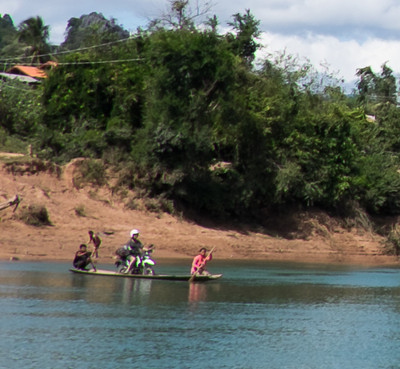The Ho Chi Minh Trail: Southern Laos PDR
- Tim Morch
- Feb 19, 2017
- 5 min read
After a smooth ride to Nong Chan, near the Vietnam border, we turned south to get lost. Just outside town, Astried had her first flat tire. Fortunately, there is a tire fixer everywhere – ours was 200m distant. With a new tube installed and a spare in hand, we reached our first section of the Ho Chi Minh Trail near the village of Langkang.
The Ho Chi Minh Trail is a network of trails used by the North Vietnamese Army to transport personnel and supplies south during the Vietnam war by going through Laos and around the US Army. As a result, Laos, a country that was not involved in the war, became subject to covert bombing by the US. By the end of the war, it had earned the dubious distinction of being the most bombed country on the planet. Today, you spot random bomb casings everywhere.
Winding along the dirt track we were alone. Occasionally, a tiny village popped-up on the banks of the river, but vehicles a rarity. Climbing and descending hills, we circle colossal karst outcroppings, enter a shaded jungle section, and return into the intense sun.
Riding the Ho Chi Minh Trail
The rainy season was over leaving the roads scarred by runoff. Ravines cut deeply into the earth. Arriving at the Xe Bangfai River, we discover the bridge was washed out. The current was too powerful to even consider riding across, so we sat and pondered options.
Slightly upstream on the river's edge, a husband-and-wife team sat with a narrow riverboat. They smiled and beckoned. I knew if I did not roll onto that narrow boat, the journey was finished. Without ca word, I rolled down the steep embankment, onto the boat, placed my feet on the gunnels, and sat incredibly still. They paddled me across without a hitch and I slid off, hammering the throttle to climb the steep bank.
Across the river, I sensed Astried was growing uneasy. I hollered instructions and she rolled into the dugout. The couple steadied her and paddled across. Successfully atop the embankment, she dropped to the ground to smoke a cigarette and calm her nerves. Her eyes were as big as saucers.
“I thought you were going to come back across and take my bike,” she finally managed to say.
Crossing Xe Bangfai River
After several kilometers of dirt track, an incongruous asphalt road appeared and we rode into e frontier town of Bua La Pha, stopping at a 'pho' restaurant.
Pho is a classic Vietnamese soup that has been adopted in these parts as the standard meal. A sumptuous broth with bits of whatever you choose inside, accompanied by a plate of vegetables to add to the mix.
The owner asked where we were going and when I told her, she nodded, saying “many rivers.” After some probing, I discovered most were small but others could be waste deep or more. Adventure lay ahead, that was certain.
Which Way to Ho Chi Minh Trail?
The road seemed to end in a field at the south end of Bua La Pha, so I asked a woman for directions. I tend to stop and ask directions frequently, and prefer to ask women. The reason is simple: if a woman does not know, she will say so. A man will just point in a random direction to save face. In my experience, this applies worldwide.
The woman pointed to the track left and said to turn right after the bridge. Bridge is an even more loosely interpreted term in this part of the country. More often than not, it refers to a cluster of planks the width of a motorcycle tire that you pray will hold your weight.
Safely across, we spot two tracks, one leading right and one straight ahead. As we discuss which might be correct, a man appears and points straight ahead. A second man crosses the bridge and points right. A third tells us to turn back.
A fourth shows up and says to follow him, he is going the same way. Thanking everyone, we chased our guide, who was disappearing into the dust ahead. The first stream crossing was shallow, and the water just touches the engines. A wider, deeper stream causes the motor to hiss. After a few more, we reach Khok village. Our guide is already assembling a class for photos. He smiles and tells us to carry on straight ... so we do.
Two hundred meters later, we arrive at a swift flowing river. We watched a guy cross on a motorcycle and noted the depth when he jumped off the stalled, mostly submerged bike to push it across. A second had the same result, so we thought to get a lift across on a tuk-tuk.
By this point, a small crowd had gathered to watch. One man pointed a little upstream. The depth appeared the same and the current perhaps slightly stronger, but it was shorter to a sandbar in the middle of the river.
I decided to give it a shot, powered in, got half-way across, and stalled out waist deep in water. I pushed to the sandbar, dried the spark plugs and caps and crossed my fingers. Thankfully, “Little Red” fired and I motioned Astried to come across. Her bike was taller, but it stalled mid-way, and I waded in to help push. Her bike fired after drying, and we motored through the second section. Soon, we were back on a dirt road in the middle of nowhere.
The trail became surprisingly good for the next 30km, barring the usual array of potholes and ravines. There were several junctions where we had to make decisions. The GPS, paper map and Google Maps (when there was signal) frequently failed to correlate.
Astried has a terrible sense of direction but a remarkable instinct. At a junction, I favoured the direction of a village visible on the GPS (not on the map or Google) and asked her feeling. Her gut said the same, and off we went. It was astonishing how many times her intuition matched my compass.
Winding along, we popped out of the jungle into the town of Villabouly. It is a mining town, evidenced by the stripped hilltops to the east. I wondered what Ho Chi Minh and would think of this. Development is pushing into the jungle for mineral and water resources, of which there appears to be plenty.
We stopped for coffee and the young woman told us they rarely saw foreigners. As an afterthought, she said a group of 4 motorcycles with a guide had been through not long ago. When I asked how long ago, she replied “maybe five months”.
































